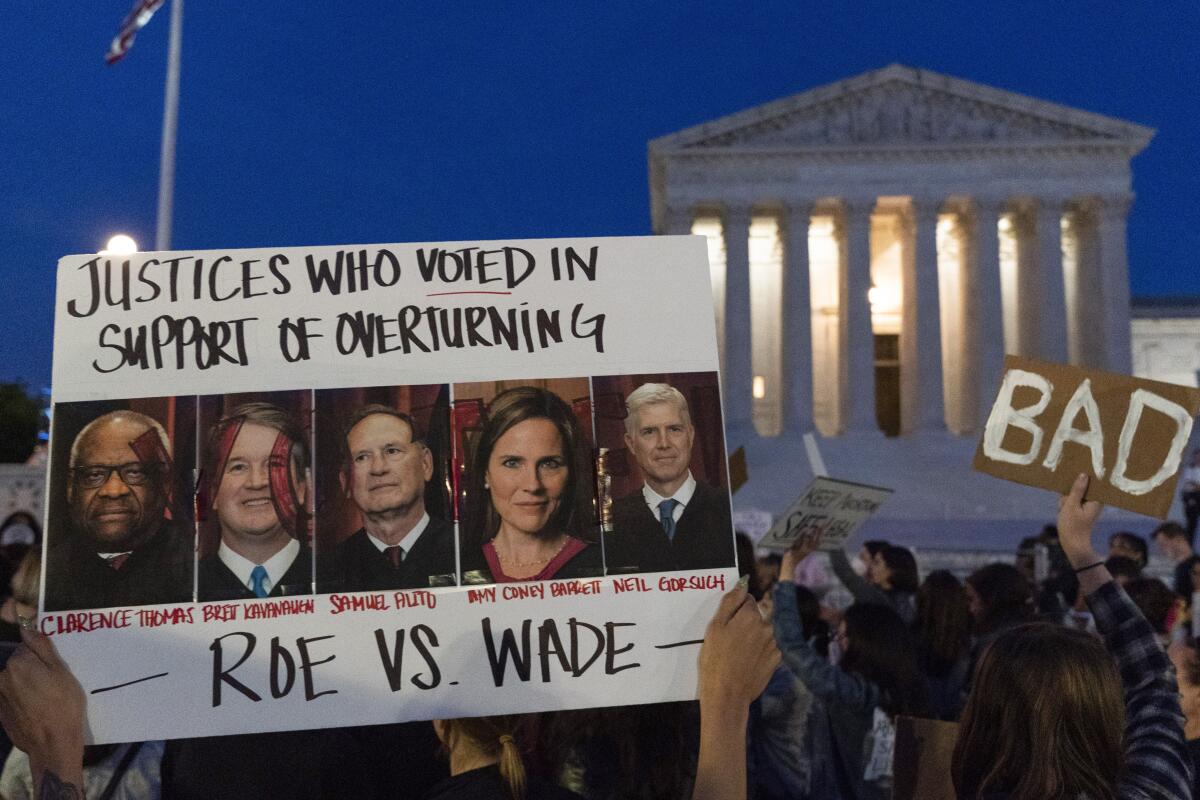Column: 50 years after Roe, the fight for abortion rights is starting over

This should’ve been a moment for celebration.
A time to celebrate the continuing expansion of American rights, and especially a woman’s right to make her own choices about her body and her future. A time to celebrate the Constitution as not merely the legalistic, literal words laid down by the 18th century founders, but rather as a dynamic document that can speak to society’s 21st century needs.
But no. On the 50th anniversary of the Supreme Court’s Roe vs. Wade decision declaring abortion to be a woman’s constitutional right, when there should have been dancing in the streets, we are instead still reeling in shock at how the clock has been turned backward.
Opinion Columnist
Nicholas Goldberg
Nicholas Goldberg served 11 years as editor of the editorial page and is a former editor of the Op-Ed page and Sunday Opinion section.
With the court’s radical about-face in Dobbs vs. Jackson Women’s Health Organization last June, which overturned Roe as if it had never existed, the country has been suddenly tossed into the past.
It was Jan. 22, 1973, when Roe was handed down.
In those days not only was abortion not a right, but same-sex marriage was still 40 years away and “sodomy” was illegal in many states. Laws banning interracial marriage and guaranteeing the right to use contraception without fear of cops marching into your bedroom had been struck down only a few years earlier.
In 1973, women couldn’t easily get credit cards in their own names and could be fired if they became pregnant. Some states made it difficult for them to serve on juries. Elective abortion was illegal in 30 states.
Is that the world we want to go back to? Is that the direction the Supreme Court is taking us?
On the day the Roe decision was announced — a cool, lightly rainy day in Washington — Alan F. Guttmacher, president of the Planned Parenthood Federation of America, sounded exultant: “By this act, hundreds of thousands of American women every year will be spared the medical risks and emotional horrors of back street and self induced abortions.”
Many people believed the abortion debate was over.
“The court’s 7-2 ruling could bring to an end the emotional and divisive public argument over what should always have been an intensely private and personal matter,” editorialized the New York Times.
That couldn’t have been more wrong.
The Los Angeles Times offered a more accurate glimpse into the future when it quoted Cardinal Patrick O’Boyle, the Roman Catholic archbishop of Washington, saying: “I do not believe we can relax our stance on such a widespread evil lest our people think that because of the Supreme Court’s decision, abortion no longer is murder.”
That was a declaration of war.
And so began 50 years during which anti-abortion forces never backed down, never gave up hope of overturning Roe. Speaking on behalf, they said, of millions of unborn babies, the “right to life” movement spread well beyond Catholics to include a broader religious right and others.
They tried to humanize the so-called unborn. They passed restrictive laws seeking to chip away, state by state, at Roe (as well as the subsequent court rulings that upheld Roe’s basic conclusions). They blocked abortion clinics. They passed out photos of aborted fetuses. Extremists threatened harassment, vandalism and violence, and sometimes carried it out.
Abortion opponents tried to associate their cause with the civil rights movement, comparing Roe to the Supreme Court’s 1857 Dred Scott decision denying citizenship and constitutional rights to African Americans. They compared deaths from abortion to the Holocaust.
I accept that most in this movement sincerely believe that innocent lives are being taken. I don’t think that the sole aim of most abortion opponents is to “control women’s bodies.”
But I don’t believe some Americans have the right to tell others how to live their lives, or to impose their own morality on women’s most personal decisions.
A pregnant woman should be allowed to determine her own future and make decisions about her own body. The rights of a fetus — whether you consider it “alive” or not in its early development — don’t outweigh those of the mother.
Furthermore, children should be born to parents who want them and can care for them.
A substantial majority of Americans support abortion rights and had hoped the court would uphold Roe. According to the Guttmacher Institute (named for the doctor quoted above), there were more than 900,000 legal, induced abortions in the U.S. in 2020.
But the overturning of Roe also has ramifications that go beyond abortion. Roe was not a stand-alone case, but was one in a long line of decisions protecting Americans from government interference in personal, private, intimate decisions involving physical autonomy and bodily integrity, family relationships, child rearing and procreation. That includes the right to use contraception, to marry whom you want and to engage in the sort of consensual sex you want in your own home.
Thanks to Justice Samuel A. Alito Jr.’s ruling in the Dobbs case, however, these decisions are all potentially endangered because the rights they confer are not specifically enumerated in the Constitution and may not be “deeply rooted,” as Alito put it, in the nation’s history and traditions.
Alito tried to suggest those decisions were not imperiled, but they obviously are, though they have made this a better, freer, fairer country.
At this particular moment in history, when we should be celebrating a half-century of progress, it is depressing to be grieving instead for rights that have been withdrawn, and for the greater distance we now have to travel if the United States is ever to achieve its twin goals of liberty and equality.
The most that can be said on this sad anniversary is that the fight for reproductive rights will continue, despite the court’s ruling. For another 50 years, if that’s what it takes.
More to Read
A cure for the common opinion
Get thought-provoking perspectives with our weekly newsletter.
You may occasionally receive promotional content from the Los Angeles Times.












